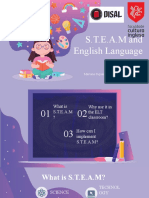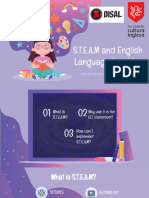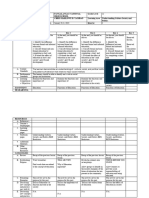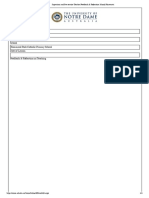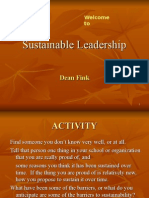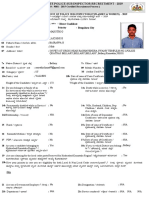Professional Documents
Culture Documents
Student Success Program - Sample Script: Five Senses of Success
Student Success Program - Sample Script: Five Senses of Success
Uploaded by
Klaudine Kyle K. SantosOriginal Description:
Original Title
Copyright
Available Formats
Share this document
Did you find this document useful?
Is this content inappropriate?
Report this DocumentCopyright:
Available Formats
Student Success Program - Sample Script: Five Senses of Success
Student Success Program - Sample Script: Five Senses of Success
Uploaded by
Klaudine Kyle K. SantosCopyright:
Available Formats
Student Success Program – Sample Script
Five Senses of Success
Students contacted by Student Success Program are assessed for their strength against the five
domains contributing to students’ capacity to engage and succeed in their learning at RMIT
(Lizzio, 2006).
Sense of
Capability
Sense of Sense of
Sense of
Resource Academic Purpose
fulness Culture
Sense of
Connected
ness
The Student Success Program increases the sense of ‘Connectedness’ by:
employing senior students with previous leadership experience who model successful
attitudes and learning practices;
encouraging students to connect with others by joining in organised student activities;
normalising and encouraging students to engage with their teaching staff.
The Student Success Program develops a student’s sense of ‘Purpose’ by:
connecting them with senior students in their discipline;
strengthening the connection between their study and their vocational direction;
referring them to the Careers Service for advice.
The Student Success Program increases a student’s sense of ‘Capability’ by:
providing effective learning strategies;
referring students to learning supports provided by their School and Student Services;
clarifying with students what is expected of them to succeed at RMIT.
The Student Success Program improves a student’s sense of ‘Resourcefulness’ by:
showing where to find resources and support on campus and online;
showing how to ‘navigate’ their way through RMIT procedures;
RMIT Student Success Program – Sample Script
Artefact - A Good Practice Guide: Safeguarding Student Learning Engagement
advising on how to achieve a balance between study and other commitments.
The Student Success Program enhances a sense of ‘Academic Culture’ by:
enlisting peers to tell students ‘how things are done’ at RMIT and in their School;
communicating messages that increase students’ identity as an independent learner in
Higher Education.
A ‘Whole-of-Person’ Approach is necessary
It is necessary to take a ‘whole-or-person’ approach to student success, as students’ personal,
social and academic circumstances impact on their learning engagement and performance.
Students benefit from a range of personal and academic supports.
Sample script below:
Hi, my name is (your name) and I’m calling from RMIT University, it that ____________?
Hi, my name is (your name) and I’m calling from RMIT University, it that ____________?
Great. __________ I’m a member of the Student Success Team in the school of Applied Sciences.
Great. __________ I’m a member of the Student Success Team in the school of Applied Sciences. The
The Student
Student Success
Success Team Team calls students
calls students to tell
to tell you youtheabout
about the and
supports supports and available
resources resourcesatavailable at
RMIT so that
RMIT so get
you can thatyour
youbest
can results.
get your best results.
What was last
What was lastweek
weekatatuniunilike?
like?
IsIs this your first
this your firstyear
yearatatuni?
uni?
a.
a. Sense
Sense of Purpose
Purpose
a.
a. How interestinghave
How interesting haveyouryourclasses
classes been
been so far?
so far?
b. What
b. What is your
yourinterest
interestininstudying engineering?
studying engineering?
b. Sense
b. Sense of
of Capacity
Capacity
a.
a. HowHow well
well did
didyou
youunderstand
understand what was
what wastaught last last
taught week?week?
b. Are you accessing Blackboard
b. Are you accessing Blackboard ok? ok?
c.c. Sense
Sense of Resourcefulness
of Resourcefulness
a. Do you know how to look up the student timetable?
a.
b. DoCanyouyouknow
log intohow to lookand
‘myRMIT’ up view
the student timetable?
the announcements?
b. Can you log into ‘myRMIT’ and view the announcements?
c. How well are you balancing study with the other things commitments you
c. Howhave?well are you balancing study with the other things commitments
d. Sense ofyou have?
Connectedness
d. Sense a. ofDidConnectedness
you get to meet some people last week?
a.
b. Did
Doesyou get tolive
anyone meet
close some people last week?
to you?
c. Does
b. Whereanyone
do the students
live close in your program go between classes?
to you?
d. If you needed to contact your
c. Where do the students in your program teachers, howgowould you do
between that?
classes?
e. Have you checked out the Clubs and Societies yet?
d. If you needed to contact your teachers, how would you do that?
e. Sensee. ofHave
Culture
you checked out the Clubs and Societies yet?
a. In what ways is uni what you expected?
e. Sense of Culture
b. Has anyone in your family been to uni?
a. In what ways is uni what you expected?
b. Has anyone in your family been to uni?
Reference:
Lizzio, A. (2006). Designing an orientation and transition strategy for commencing students. A
conceptual summary of research and practice. Griffith University: First Year Experience Project.
Retrieved from http://www.griffith.edu.au/__data/assets/pdf_file/0008/51875/Alfs-5-
Senors-Paper-FYE-Project,-2006.pdf
RMIT Student Success Program – Sample Script
Artefact - A Good Practice Guide: Safeguarding Student Learning Engagement
You might also like
- Cover Letter COWIDocument1 pageCover Letter COWIRavi Salimath100% (1)
- S.T.E.A.M and English Language Teaching: Mariana Siqueira - Cultura Inglesa São PauloDocument25 pagesS.T.E.A.M and English Language Teaching: Mariana Siqueira - Cultura Inglesa São PauloHuong Le100% (2)
- SIR PAUL Answer KeyDocument18 pagesSIR PAUL Answer KeyGlory Mae BastarecheNo ratings yet
- Behavioral Skills in BusinessDocument6 pagesBehavioral Skills in Businesshaoao70% (10)
- LEp-6-Activity 5-13-24Document9 pagesLEp-6-Activity 5-13-24Cherith May DelgadoNo ratings yet
- Question Bank UGC NET Paper 1 (2000 MCQ'S)Document2,677 pagesQuestion Bank UGC NET Paper 1 (2000 MCQ'S)RickdenBhutiaNo ratings yet
- Rubric For Online Instruction: RationaleDocument7 pagesRubric For Online Instruction: RationaleJimy OblitasNo ratings yet
- Direct Instruction Lesson Plan-2Document2 pagesDirect Instruction Lesson Plan-2api-488065802No ratings yet
- S.T.E.A.M and ELTDocument25 pagesS.T.E.A.M and ELThtsantos6550No ratings yet
- Ucsp 2023 DLLDocument19 pagesUcsp 2023 DLLCHRIS MARLOWE YAMBAONo ratings yet
- DLL Daily Lesson Log inDocument6 pagesDLL Daily Lesson Log inqyalmonicar8381valNo ratings yet
- Chapter 6Document21 pagesChapter 6Junaifa PacasumNo ratings yet
- Teaching Lesson Plan (Direct Instruction) : Kaitlin Milam History - MesoamericaDocument2 pagesTeaching Lesson Plan (Direct Instruction) : Kaitlin Milam History - Mesoamericaapi-372927823No ratings yet
- Grade 5 DLL English 5 Q2 Week 8Document4 pagesGrade 5 DLL English 5 Q2 Week 8kotarobrother23No ratings yet
- Jay With Answers 1 SummaryDocument23 pagesJay With Answers 1 Summaryshyra hamidNo ratings yet
- Prof Ed Drill4Document4 pagesProf Ed Drill4Ryan M. TigbaoNo ratings yet
- Ce 13Document4 pagesCe 13api-621539682No ratings yet
- Ed4a Profed QuizDocument2 pagesEd4a Profed QuizNABUA MARY CRYSTALLINE S.No ratings yet
- Online Let Reviewer PDFDocument31 pagesOnline Let Reviewer PDFmary100% (1)
- S.Y. 2019-2020 Daily Lesson Plan Grade 11-Oral CommunicationDocument3 pagesS.Y. 2019-2020 Daily Lesson Plan Grade 11-Oral CommunicationLingerfaith Mayor MoralesNo ratings yet
- English Mock QPDocument13 pagesEnglish Mock QPSattiki DasNo ratings yet
- Lesson Plan ETECH v2Document37 pagesLesson Plan ETECH v2Puche MaraNo ratings yet
- Elements of Teaching and Learning: Cavite State UniversityDocument9 pagesElements of Teaching and Learning: Cavite State UniversityDaniel LorioNo ratings yet
- NCBTS Volume 1 Principles Edtec Curdev Devread FS 101 150Document102 pagesNCBTS Volume 1 Principles Edtec Curdev Devread FS 101 150justin may tuyor100% (1)
- DLL English q1 Week 5Document12 pagesDLL English q1 Week 5Alexandra HalasanNo ratings yet
- Cot English Grade 6 QTR 2 Distinguishing Print MediaDocument19 pagesCot English Grade 6 QTR 2 Distinguishing Print MediaGener RodelasNo ratings yet
- Session 1 Session 2 Session 3 Session 4: I. ObjectivesDocument3 pagesSession 1 Session 2 Session 3 Session 4: I. ObjectivesSherwin SantosNo ratings yet
- Sonia - Supervisor and Pre-Service Teacher Feedback Reflection School PlacementDocument4 pagesSonia - Supervisor and Pre-Service Teacher Feedback Reflection School Placementapi-451268851No ratings yet
- Araw 6Document2 pagesAraw 6Dindo Arambala OjedaNo ratings yet
- Lesson Plan ETECH v2Document39 pagesLesson Plan ETECH v2Jennyvi NapodNo ratings yet
- Nqesh Mock Test 2Document20 pagesNqesh Mock Test 2THESSA ABADNo ratings yet
- Week1 - Persuasion - Reading and Writing - Lesson ExemplarDocument5 pagesWeek1 - Persuasion - Reading and Writing - Lesson ExemplarArianne ManuelNo ratings yet
- Mary The Queen College of Quezon City: Practice Exercise Teaching ProfessionDocument4 pagesMary The Queen College of Quezon City: Practice Exercise Teaching ProfessionCatherine Paguntalan Sta RosaNo ratings yet
- Learning Episode 3Document6 pagesLearning Episode 3Justine Ann LlidoNo ratings yet
- Mapeh DLL 10Document3 pagesMapeh DLL 10Charrie Mae Mallo0% (1)
- Working With Gifted StudentsDocument10 pagesWorking With Gifted StudentsmNo ratings yet
- DLL in Eapp Day 1-4Document4 pagesDLL in Eapp Day 1-4Marinella BorbonNo ratings yet
- Adjectives DLPDocument9 pagesAdjectives DLPOGALINOLA CRISTINE JEWEL D.No ratings yet
- Multiple Reading Strategies Lesson PlanDocument5 pagesMultiple Reading Strategies Lesson PlanJullie Ann EspinosaNo ratings yet
- Nepf Lesson Plan PrepDocument2 pagesNepf Lesson Plan Prepapi-479671213No ratings yet
- Lesson Plan CONTEMPORARYDocument11 pagesLesson Plan CONTEMPORARYLeoniel L. RonsableNo ratings yet
- Field Study ReviewerDocument8 pagesField Study ReviewerKa Roger Man-ao PepitoNo ratings yet
- Lesson Plan ETECH v2Document41 pagesLesson Plan ETECH v2helen adoNo ratings yet
- Semi Detailed LPDocument2 pagesSemi Detailed LPSatsuki Elieza Villaron RustiaNo ratings yet
- Joji Ilagan Bian College of Business and TourismDocument40 pagesJoji Ilagan Bian College of Business and TourismPamela SantiagoNo ratings yet
- AssessmentasksDocument20 pagesAssessmentasksRhea Asuncion SorianoNo ratings yet
- TIP ActivityDocument14 pagesTIP ActivityMaria Dian JoaquinoNo ratings yet
- FC For PrintDocument9 pagesFC For PrintChe CheNo ratings yet
- Daily Lesson LOG Semester 2 Quarter: ST NDDocument3 pagesDaily Lesson LOG Semester 2 Quarter: ST NDRonzel BarteNo ratings yet
- Lesson Plan APP6Document11 pagesLesson Plan APP6Elenear De OcampoNo ratings yet
- CATCH UP FRIDAY March8 COMPLETEDocument12 pagesCATCH UP FRIDAY March8 COMPLETEJoy T. TatadNo ratings yet
- Week-03 DLPDocument18 pagesWeek-03 DLPDapadap, Emyjoy L.No ratings yet
- 2 Nov 14-18Document3 pages2 Nov 14-18Noelyn FloresNo ratings yet
- Semi Lesson Plan Group 4Document3 pagesSemi Lesson Plan Group 4rainevienneNo ratings yet
- UntitledDocument3 pagesUntitledVince GomezNo ratings yet
- Metacognition Rubric MYPDocument4 pagesMetacognition Rubric MYPgabrielaNo ratings yet
- History-Social Science, Grade 3: Date: July 7, 2021 Candidate: Leigh Anteola Context/Grade LevelDocument3 pagesHistory-Social Science, Grade 3: Date: July 7, 2021 Candidate: Leigh Anteola Context/Grade Levelapi-557514903No ratings yet
- Math Finals Demo To TTLDocument7 pagesMath Finals Demo To TTLmaryheart.evite.sNo ratings yet
- Empowering Education: Nurturing Critical Thinkers and Proficient Communicators for a Changing WorldFrom EverandEmpowering Education: Nurturing Critical Thinkers and Proficient Communicators for a Changing WorldNo ratings yet
- Collins Little Learners - Art & Craft_UKGFrom EverandCollins Little Learners - Art & Craft_UKGRani TNo ratings yet
- Chapter 12Document13 pagesChapter 12Klaudine Kyle K. SantosNo ratings yet
- EnglishDocument42 pagesEnglishKlaudine Kyle K. SantosNo ratings yet
- Tourism Enterprise Zone PresentationDocument42 pagesTourism Enterprise Zone PresentationKlaudine Kyle K. SantosNo ratings yet
- Consumer Behavior: Principles of Marketing - Adu Shs Prepared By: Iana Ryne Adorable, Mba, LPTDocument49 pagesConsumer Behavior: Principles of Marketing - Adu Shs Prepared By: Iana Ryne Adorable, Mba, LPTKlaudine Kyle K. SantosNo ratings yet
- College Candy Aesthetics by SlidesgoDocument55 pagesCollege Candy Aesthetics by SlidesgoKlaudine Kyle K. SantosNo ratings yet
- Travel Agency Brochure by SlidesgoDocument40 pagesTravel Agency Brochure by SlidesgoKlaudine Kyle K. SantosNo ratings yet
- Ethics Reporters: GROUP 1 (Sabado, Asupardo, Salditos, Triumfante)Document1 pageEthics Reporters: GROUP 1 (Sabado, Asupardo, Salditos, Triumfante)Klaudine Kyle K. SantosNo ratings yet
- Neon Aesthetics Project Portfolio by SlidesgoDocument47 pagesNeon Aesthetics Project Portfolio by SlidesgoKlaudine Kyle K. SantosNo ratings yet
- Topic For ReportingDocument1 pageTopic For ReportingKlaudine Kyle K. SantosNo ratings yet
- Santos (Hms2c) 1Document2 pagesSantos (Hms2c) 1Klaudine Kyle K. SantosNo ratings yet
- Telephone Rings 2x: AgentDocument2 pagesTelephone Rings 2x: AgentKlaudine Kyle K. Santos100% (1)
- 82Document80 pages82nemchandNo ratings yet
- Arthritis Center Brochure 10-25-2011Document2 pagesArthritis Center Brochure 10-25-2011kec kalimatNo ratings yet
- Demelash Seifu Review ArticleDocument5 pagesDemelash Seifu Review ArticleDemelash SeifuNo ratings yet
- Sustainable Leadership ConceptsDocument69 pagesSustainable Leadership Conceptssim4mis6084100% (3)
- The Impact of Spiritual Care Education UDocument5 pagesThe Impact of Spiritual Care Education URahmida RahmyNo ratings yet
- Maths Sirpi Academy Dindigul: Topic STD & Term Unit Title Page NoDocument2 pagesMaths Sirpi Academy Dindigul: Topic STD & Term Unit Title Page NoKamali KalaNo ratings yet
- Maruthi HK PsiDocument3 pagesMaruthi HK PsiKarthik GhorpadeNo ratings yet
- MDMSPG 2022Document104 pagesMDMSPG 2022Binayak UpadhyayaNo ratings yet
- G2 - DR - SI - 23 Meet Tom LambDocument5 pagesG2 - DR - SI - 23 Meet Tom LambPhạm SửuNo ratings yet
- Self Concept and Academic PerformanceDocument21 pagesSelf Concept and Academic PerformanceLove Ko To OltorabNo ratings yet
- Admission & Merit CriteriaDocument3 pagesAdmission & Merit Criteriafarhan hanifNo ratings yet
- CV - M Suryo Panotogomo Abi SurosoDocument3 pagesCV - M Suryo Panotogomo Abi SurosoSuryo Abi SurosoNo ratings yet
- SOA Assignment CoverDocument1 pageSOA Assignment CoverVanisha KumarNo ratings yet
- Skill of Speaking: Teacher's Role in The Development of Speaking Skill Among The StudentsDocument41 pagesSkill of Speaking: Teacher's Role in The Development of Speaking Skill Among The StudentsShakila ShakiNo ratings yet
- Clinical Consultant Informatics Educator in Orlando FL Resume Joy MossDocument2 pagesClinical Consultant Informatics Educator in Orlando FL Resume Joy MossJoyMossNo ratings yet
- DLL Week 2Document4 pagesDLL Week 2AILYN PECASALES100% (1)
- PHD STUDENT MANUALDocument23 pagesPHD STUDENT MANUALFaisal AliNo ratings yet
- C6 PDFDocument4 pagesC6 PDFgerardoNo ratings yet
- Lesson Plan: Al Tarbiyah Al Namouthajiyah International Schools Semester 2 (Week 2)Document3 pagesLesson Plan: Al Tarbiyah Al Namouthajiyah International Schools Semester 2 (Week 2)Queen1982 KNo ratings yet
- QP Assessors Prep. Test PDFDocument34 pagesQP Assessors Prep. Test PDFVishavjit l. BhanavaseNo ratings yet
- Module 1 QdeDocument7 pagesModule 1 QdeRoderick pasocoNo ratings yet
- Diagnostic Sat Answer KeyDocument2 pagesDiagnostic Sat Answer KeyMilestone EgyptNo ratings yet
- You May Ask Yourself What Is TechnologyDocument11 pagesYou May Ask Yourself What Is TechnologyAda MoralesNo ratings yet
- Charities USA Winter 2014Document32 pagesCharities USA Winter 2014Catholic Charities USANo ratings yet
- Challenges of Modular Distance LearningDocument8 pagesChallenges of Modular Distance LearningIna100% (1)
- Addl Exam Centre May 2020 InstructionssDocument2 pagesAddl Exam Centre May 2020 Instructionssshruti soniNo ratings yet
- Illegal Recruiting2Document22 pagesIllegal Recruiting2api-260363651No ratings yet
- Group 1 FINAL RESEARCH (Earth)Document28 pagesGroup 1 FINAL RESEARCH (Earth)AlexisNo ratings yet

